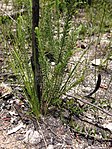
Acacia acinacea, commonly known as gold dust wattle, is a flowering shrub. It is native to south eastern Australia and lives for 15 years on average. They are tolerant of drought and frost. It is a species of wattle, and is also known as wreath wattle or round-leaf wattle.

Acacia maitlandii, also known as Maitland's wattle, is a perennial tree native to Australia.
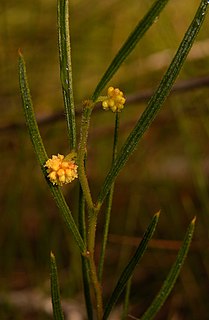
Acacia bynoeana, known colloquially as Bynoe's wattle or tiny wattle, is a species of Acacia native to eastern Australia. It is listed as endangered in New South Wales and as vulnerable according to the Environment Protection and Biodiversity Conservation Act 1999.

Acacia burkittii is a species of wattle endemic to Western Australia, South Australia and western New South Wales, where it is found in arid zones, and is a perennial shrub in the family Fabaceae. Common names for it include Burkitt's wattle, fine leaf jam, gunderbluey, pin bush and sandhill wattle. It has also been introduced into India. Previously this species was referred to as Acacia acuminata subsp. burkittii, but is now considered to be a separate species. Grows in mallee, eucalypt and mulga woodland or shrubland, often on sandhills.

Acacia amblygona, commonly known as fan wattle or fan leaf wattle, is a shrub belonging to the genus Acacia and the subgenus Phyllodineae that is native to Australia.

Acacia georgensis, commonly known as Bega wattle or Dr George Mountain wattle, is a species of Acacia native to southeastern Australia. It was one of eleven species selected for the Save a Species Walk campaign in April 2016 when scientists walked 300 km to raise money for collection of seeds to be prepared and stored at the Australian PlantBank at the Australian Botanic Garden Mount Annan.

Acacia oswaldii, commonly known as boree, umbrella wattle, umbrella bush, whyacka, middia, miljee, nella and curly yarran, is a shrub or tree of the genus Acacia and the subgenus Plurinerves.

Acacia aureocrinita is a shrub belonging to the genus Acacia and the subgenus Phyllodineae that is native to parts of eastern Australia.

Acacia burbidgeae, commonly known as Burbidge's wattle, is a shrub or tree belonging to the genus Acacia and the subgenus Phyllodineae that is endemic to parts of New South Wales and Queensland.

Acacia calamifolia, commonly known as wallowa or reed-leaf wattle, is a shrub or tree belonging to the genus Acacia and the subgenus Phyllodineae endemic to south eastern parts of Australia.

Acacia barringtonensis, commonly known as Barrington wattle, is a shrub belonging to the genus Acacia and the subgenus Phyllodineae endemic to New South Wales.

Acacia falciformis, also commonly known as broad-leaved hickory, hickory wattle, mountain hickory, large-leaf wattle, tanning wattle and black wattle, is a shrub belonging to the genus Acacia and the subgenus Phyllodineae that is endemic to eastern Australia
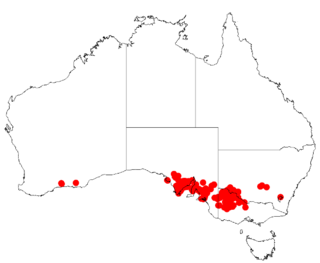
Acacia halliana is a shrub belonging to the genus Acacia and the subgenus Phyllodineae that is native to parts of south eastern Australia.
Acacia nova-anglica, commonly known as New England hickory, is a shrub belonging to the genus Acacia and the subgenus Phyllodineae that is endemic to eastern Australia.
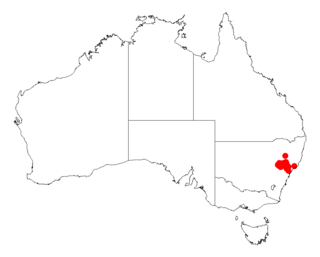
Acacia piligera, also known as grub-pod wattle, is a tree or shrub belonging to the genus Acacia and the subgenus Phyllodineae native to eastern Australia.
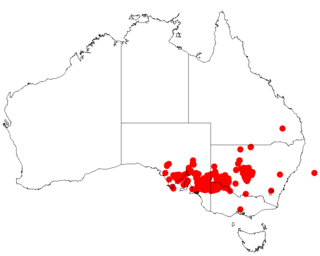
Acacia wilhelmiana, commonly known as dwarf nealie, Wilhelmi’s wattle and mist wattle, is a shrub belonging to the genus Acacia and the subgenus Plurinerves native to the mallee region of central and eastern Australia.

Acacia torringtonensis is a shrub belonging to the genus Acacia and the subgenus Phyllodineae native to eastern Australia.

Acacia blakei, commonly known as Blake's wattle or Wollomombi wattle, is a shrub belonging to the genus Acacia and the subgenus Juliflorae that is native to north eastern Australia.
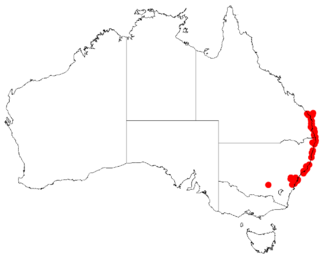
Acacia baueri, commonly known as tiny wattle, is a shrub belonging to the genus Acacia and the subgenus Lycopodiifoliae that is native to an area along the coast in eastern Australia.

Acacia baeuerlenii is a shrub of the genus Acacia and the subgenus Plurinerves that is endemic to a small area in eastern Australia.




